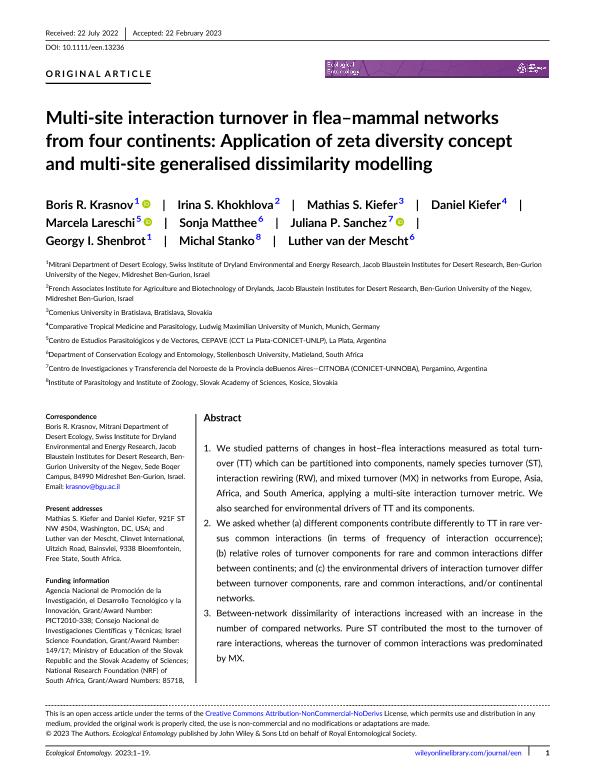Mostrar el registro sencillo del ítem
dc.contributor.author
Krasnov, Boris R.
dc.contributor.author
Khokhlova, Irina S.
dc.contributor.author
Kiefer, Mathias S.
dc.contributor.author
Kiefer, Daniel
dc.contributor.author
Lareschi, Marcela

dc.contributor.author
Matthee, Sonja
dc.contributor.author
Sánchez, Juliana Patricia

dc.contributor.author
Shenbrot, Georgy I.
dc.contributor.author
Stanko, Michal
dc.contributor.author
van der Mescht, Luther
dc.date.available
2023-12-14T15:12:48Z
dc.date.issued
2023-04
dc.identifier.citation
Krasnov, Boris R.; Khokhlova, Irina S.; Kiefer, Mathias S.; Kiefer, Daniel; Lareschi, Marcela; et al.; Multi-site interaction turnover in flea–mammal networks from four continents: Application of zeta diversity concept and multi-site generalised dissimilarity modelling; Wiley Blackwell Publishing, Inc; Ecological Entomology; 48; 4; 4-2023; 1-19
dc.identifier.issn
0307-6946
dc.identifier.uri
http://hdl.handle.net/11336/220377
dc.description.abstract
We studied patterns of changes in host–flea interactions measured as total turnover (TT) which can be partitioned into components, namely species turnover (ST), interaction rewiring (RW), and mixed turnover (MX) in networks from Europe, Asia, Africa, and South America, applying a multi-site interaction turnover metric. We also searched for environmental drivers of TT and its components. We asked whether (a) different components contribute differently to TT in rare versus common interactions (in terms of frequency of interaction occurrence); (b) relative roles of turnover components for rare and common interactions differ between continents; and (c) the environmental drivers of interaction turnover differ between turnover components, rare and common interactions, and/or continental networks. Between-network dissimilarity of interactions increased with an increase in the number of compared networks. Pure ST contributed the most to the turnover of rare interactions, whereas the turnover of common interactions was predominated by MX. The effects of environmental factors, interaction richness, and spatial distance on TT and its components differed between continental networks, turnover components, and rare versus common interactions. Climate and vegetation exerted the strongest effects on (a) ST for rare (except Asia) and, to a lesser degree, common (South America) interactions, (b) RW for both rare and common interactions in Europe/Asia, and (c) MX for both rare and common interactions (except Africa). Interaction richness and spatial distance mainly influenced ST. We conclude that the patterns of interaction turnover and its components were geographically invariant and did not depend on the identity of the interactors, whereas the drivers of the turnover differed between continental networks because of species-specific responses to the environment.
dc.format
application/pdf
dc.language.iso
eng
dc.publisher
Wiley Blackwell Publishing, Inc

dc.rights
info:eu-repo/semantics/openAccess
dc.rights.uri
https://creativecommons.org/licenses/by-nc-sa/2.5/ar/
dc.subject
DISSIMILARITY
dc.subject
ENVIRONMENT
dc.subject
FLEAS
dc.subject
MAMMALS
dc.subject
MULTI-SITE DISSIMILARITY MODELLING
dc.subject
ZETA DIVERSITY
dc.subject.classification
Zoología, Ornitología, Entomología, Etología

dc.subject.classification
Ciencias Biológicas

dc.subject.classification
CIENCIAS NATURALES Y EXACTAS

dc.title
Multi-site interaction turnover in flea–mammal networks from four continents: Application of zeta diversity concept and multi-site generalised dissimilarity modelling
dc.type
info:eu-repo/semantics/article
dc.type
info:ar-repo/semantics/artículo
dc.type
info:eu-repo/semantics/publishedVersion
dc.date.updated
2023-12-12T13:11:22Z
dc.journal.volume
48
dc.journal.number
4
dc.journal.pagination
1-19
dc.journal.pais
Reino Unido

dc.description.fil
Fil: Krasnov, Boris R.. Ben Gurion University of the Negev; Israel
dc.description.fil
Fil: Khokhlova, Irina S.. Ben Gurion University of the Negev; Israel
dc.description.fil
Fil: Kiefer, Mathias S.. Ludwig Maximilians Universitat; Alemania
dc.description.fil
Fil: Kiefer, Daniel. Ludwig Maximilians Universitat; Alemania
dc.description.fil
Fil: Lareschi, Marcela. Consejo Nacional de Investigaciones Científicas y Técnicas. Centro Científico Tecnológico Conicet - La Plata. Centro de Estudios Parasitológicos y de Vectores. Universidad Nacional de La Plata. Facultad de Ciencias Naturales y Museo. Centro de Estudios Parasitológicos y de Vectores; Argentina
dc.description.fil
Fil: Matthee, Sonja. Stellenbosch University; Sudáfrica
dc.description.fil
Fil: Sánchez, Juliana Patricia. Consejo Nacional de Investigaciones Científicas y Técnicas. Centro de Investigaciones y Transferencia del Noroeste de la Provincia de Buenos Aires. Universidad Nacional del Noroeste de la Provincia de Buenos Aires. Centro de Investigaciones y Transferencia del Noroeste de la Provincia de Buenos Aires; Argentina
dc.description.fil
Fil: Shenbrot, Georgy I.. Ben Gurion University of the Negev; Israel
dc.description.fil
Fil: Stanko, Michal. Slovak Academy of Sciences. Institute of Botany; Eslovaquia
dc.description.fil
Fil: van der Mescht, Luther. Stellenbosch University; Sudáfrica
dc.journal.title
Ecological Entomology

dc.relation.alternativeid
info:eu-repo/semantics/altIdentifier/doi/http://dx.doi.org/10.1111/een.13236
dc.relation.alternativeid
info:eu-repo/semantics/altIdentifier/url/https://resjournals.onlinelibrary.wiley.com/doi/10.1111/een.13236
Archivos asociados
